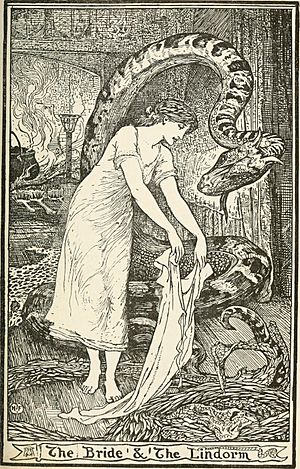King Lindworm facts for kids
Quick facts for kids King Lindworm |
|
|---|---|

The maiden amidst the Lindorm's shed skins. Illustration by Henry Justice Ford for Andrew Lang's The Pink Fairy Book (1897).
|
|
| Folk tale | |
| Name | King Lindworm |
| Also known as | Prince Lindworm |
| Data | |
| Aarne–Thompson grouping | ATU 433B (Prince Lindworm) |
| Region | Denmark |
| Published in | Gamle danske minder i folkemunde, by Svend Grundtvig (1854) |
King Lindworm, also known as Prince Lindworm, is a classic Danish fairy tale. It was first written down in the 1800s by a Danish storyteller named Svend Grundtvig. This story is part of a group of tales called ATU 433B. These tales are all about brave young women who help turn snake-like princes back into humans.
Contents
The Story of King Lindworm
This Scandinavian folklore tale begins with a queen who really wants to have children. An old wise woman tells her to eat two onions. The queen forgets to peel the first onion. Because of this, her first twin son is born as a "lindworm," which is half-man and half-snake. Her second twin son is born perfectly human.
When the younger, human prince grows up, he wants to find a bride. But the lindworm prince insists that he must get married first. Many young women are chosen to be his bride. However, the lindworm frightens them, and they are sent away.
Finally, a shepherd's daughter is brought to marry him. She had also spoken to the same wise old woman. The old woman told her exactly what to do. The shepherd's daughter wears every dress she owns. The lindworm tells her to take off her dress. But she bravely says he must shed one of his snake skins for each dress she removes. As he sheds his skins, his human form slowly appears underneath. After the last skin is shed, he becomes a handsome prince.
Some versions of this story are a bit different. They might not include the lindworm's twin brother. Also, the wise person who gives advice might be a man instead of a woman.
Lindworm Stories Around the World

Fairy tales often travel across different countries. The story of King Lindworm is found in many places. Experts believe it might have started in the East, like India or the Near East. Then it spread to places like Scandinavia, which includes Denmark and southern Sweden.
Sweden
A Swedish version of the story was shared by a famous folklorist, Andrew Lang, in his Pink Fairy Book. This version is called King Lindorm. The first part is very similar to the Danish tale. It tells about the birth of the snake-boy and his marriage to a human maiden.
The second part of the Swedish story is different. After King Lindorm becomes human, he goes off to war. He leaves his wife, who is expecting a baby, with her stepmother. The stepmother is mean and tells the king that his wife gave birth to animal babies. But a loyal servant hides the queen and her twin boys. The queen then moves to a hut in the forest. There, she meets a man named Peter. She discovers Peter made a deal with "The Evil One." The queen decides to help him break this deal using three special nuts from her mother's grave.
Germany
In Germany, there are also tales like King Lindworm. One story from South Germany is called Die Schlange ("The Snake"). In this tale, a count's wife gives birth to a snake son. When he is twenty, he asks his mother to find him a wife. On her wedding night, the bride wears seven layers of clothing. She was told to take off one layer for each snake skin her husband sheds.
Another German tale is Siebenhaut ("Sevenskins"). In this story, a count's wife gives birth to a snake after being insulted. When the snake is twenty, he asks for a wife. A maiden, guided by an angel in a dream, wears seven layers of clothing. This helps her break the snake's enchantment and turn him human.
Greece
A Greek version of the story is called The Girl With Two Husbands. In this tale, as the snake prince sheds each layer of his skin, his bride quickly throws it into a fire. This helps him become human.
Turkey
A Turkish tale is called Der Drachenprinz und die Stiefmutter ("The Dragon-Prince and the Stepmother"). In this story, a padishah (a ruler) wants a child. His wife becomes pregnant, but the baby is a dragon! A mean stepmother sends her stepdaughter to help with the dragon baby. The stepdaughter cries at her mother's grave, and her mother's spirit tells her what to do. The maiden successfully helps the dragon prince.
Later, the dragon prince wants to learn. The stepmother tries to trick her stepdaughter again, but the maiden is safe. Finally, the dragon wants to get married. Many maidens are scared away. The stepmother wants her stepdaughter to face the same fate. But the maiden is again helped by her mother's spirit. She is told to wear seven layers of clothing on her wedding night to break the dragon's spell.
Eventually, the stepmother succeeds in sending the new princess away after the now-human Dragon-Prince goes to war. The Dragon-Prince's wife then has many more adventures until she is finally reunited with her husband.
Images for kids
-
The maiden amidst the Lindorm's shed skins. Illustration by Henry Justice Ford for Andrew Lang's The Pink Fairy Book (1897).
-
The Lindworm Prince coils around his bride-to-be. Illustration by Kay Nielsen for East of the Sun and West of the Moon: Old Tales from the North (1914).



